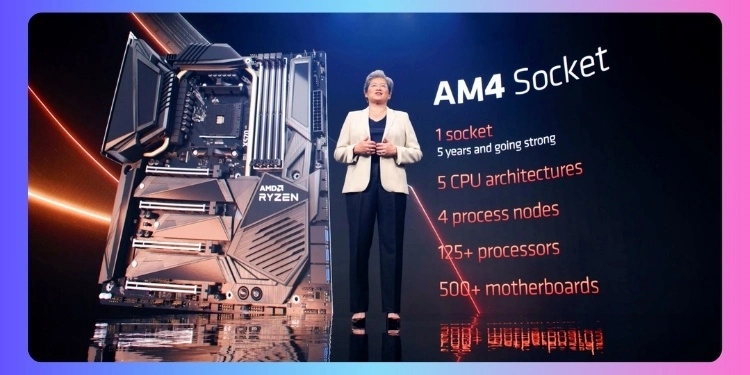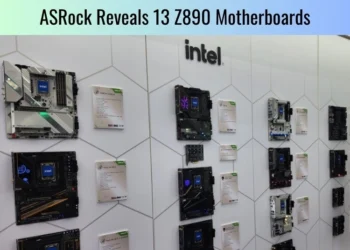If you are planning your next desktop build and are stuck deciding between AMD’s AM4 and AM5 sockets, you have come to the right place. The choice of CPU platform is crucial, affecting performance, upgrade paths, and longevity. With constant tech evolution, navigating socket differences and finding the right fit for your needs can be challenging.
This guide breaks down the critical aspects of AM4 and AM5 to help you decide. We’ll discuss AM4 vs AM5, covering specifications, capabilities, value, and future-proofing. Let’s dive in!
Critical Differences Between AM4 vs AM5
The two mainstream AMD desktop sockets right now are AM4 and AM5. While AM4 has been around since 2016, AM5 is AMD’s latest and greatest, introduced in late 2022. The key differences between these sockets include the CPU architecture support, memory support, and PCIe standards. AM4 supports CPU architectures like Zen 2 and Zen 3 and supports DDR4 memory.
In contrast, AM5 is the first socket compatible with AMD’s latest and most advanced Zen 4 microarchitecture, delivering significant single-threaded performance gains. AM5 also supports faster DDR5 memory and ushers in support of PCIe Gen 5.
A Brief History of AMD Sockets
AMD has been in the desktop CPU socket game for many years. Some critical past sockets include Socket A, which was launched in 1999 and used for AMD Athlon processors. Socket 754 followed in 2003 and was employed for Athlon 64 CPUs.
Socket 939 was introduced in 2004 and was compatible with Athlon 64 X2, Athlon 64, and Athlon 64 FX processors. AM2 debuted in 2006 and was used for Athlon II and Phenom processors, supporting DDR2 memory.
Subsequent iterations like AM2+, AM3, and AM3+ built upon the AM2 design. Both AM4 launched in 2016 and provided mainstream support for Ryzen processors, while AM5 carries forth AMD’s legacy and improves on its predecessors with new capabilities.
Socket Specifications
The specifications of the CPU socket play an essential role in defining a system’s capabilities. Key aspects distinguish the AM4 and AM5 sockets. Let’s dive deeper to compare their specifications.
Socket Type (LGA vs PGA)
The AM4 and AM5 socket types differ significantly. AM4 uses a Pin Grid Array, where the pins are located on the CPU package instead of the socket. In contrast, AM5 switches to a Land Grid Array design, with pins now located on the CPU socket for improved durability.
This means that, with the LGA approach adopted by AM5, any damages during handling or mounting would impact the socket rather than the CPU package.

Supported CPU Architecture
While AM4 supports CPU architectures like Zen 2 and Zen 3, AM5 is the first socket compatible with AMD’s most advanced Zen 4 microarchitecture. This delivers meaningful single-threaded performance gains over AM4.
Memory Support
Another critical distinction is the memory type supported – both sockets support DDR4 and DDR5, respectively. DDR5 offers higher speeds and bandwidth to enhance the system’s capabilities further.
PCIe Support
AM4 has PCIe Gen 3 and 4 support for storage and graphics cards. In contrast, the newer AM5 socket ushers in support for PCIe Gen 5, effectively doubling the available bandwidth for components. This allows for better performance and headroom for future technologies.
Performance Comparison
Performance is one of the primary considerations for any desktop build. It is crucial to understand how the AM4 and AM5 sockets compare in terms of performance. This section provides insights into their performance differences across various usage models.
Single-Core and Multi-Threaded Performance
Taking advantage of the cutting-edge Zen 4 architecture in its CPUs, am5 vs am4 delivers substantially improved single-threaded performance essential for applications and many games.
Multi-threaded workloads also see tangible and meaningful gains from AM5’s richer core counts and higher clock speeds and Infinity Fabric speeds supported by the platform.
Gaming and Productivity Workloads
The leap in performance unfolds across different usage models. Whether gaming at any resolution or tackling creative work, the AM5 platform ensures a much smoother experience thanks to reduced CPU bottlenecking. Encoding and other threaded applications also get a notable speedup due to AM5’s capabilities.
Overclocking Potential
Both AM4 and AM5 sockets are well-versed in overclocking. However, AM5’s enhanced power delivery capabilities and thermal designs facilitate higher stable clocks. Tweaking the Infinity Fabric also yields extra headroom on AM5 for squeezing out that last bit of extra performance to maximize gaming and productivity speeds.

Upgrade Path and Compatibility
The upgrade options and compatibility stance of a CPU platform are essential factors to examine. Upgrading components is made more accessible on platforms with broader compatibility. This section delves into how the AM4 and AM5 sockets differ regarding upgrade paths and compatibility.
CPU Upgrade Options
As a highly new platform, only the latest Ryzen 7000 CPUs are compatible with AM4 & AM5 sockets. In contrast, a wide range of CPUs from different generations launched in the past can be seamlessly dropped into AM4 motherboards for a cost-effective upgrade.
Motherboard Compatibility
Naturally, an AM5 socket also requires a motherboard change due to incompatibility with older AM4 boards. However, this also ensures access to cutting-edge chipset features through manufacturers’ latest X670 and B650 boards.
Cooler Compatibility
While the CPU’s dimensions and mounting screw holes are similar between AM4 and AM5 sockets, the positioning of the holes is different. This means you need an adapter or ensure direct compatibility before re-using your existing CPU cooler on AM5. New coolers with out-of-box AM5 support are also available now.
Value Assessment
Value is a significant consideration for any PC build. It is imperative to appraise the value proposition of options thoroughly. This section provides a cost-benefit analysis of AM4 and AM5 platforms to determine which offers more long-term value.
Upfront Cost Comparison
The upfront costs required for a complete AM5-based system are significantly higher than those for AM4 currently. This is because newer standards, such as high-performance DDR5 memory modules, are supported.
In addition, cutting-edge X670/B650 chipset motherboards are in demand, and they pair nicely with 3D V-Cache Zen 4 CPUs. In contrast, established platforms provide relatively more worthwhile pricing, attributable to lower expenses and a wider choice of components.
Long-Term Cost of Ownership
However, when evaluated long-term, AM5 systems have a longer and more helpful lifespan thanks to support for multiple future generations, such as Meteorlake CPUs dropping in 2023. DDR5 memory prices are also consistently falling. Factoring capabilities like faster storage and graphics, the AM5 platform provides more excellent value and lower overall cost of ownership in the long run.
Conclusion
If performance and staying on the cutting edge are the top priorities, opting for AMD AM4 vs. AMD AM5 makes complete sense. However, budget shoppers targeting basic tasks can still get decent value from proven AM4 until the next major upgrade in a few years.
Future Outlook
The AM5 platform establishes a solid foundation for AMD’s roadmap throughout this decade, with multiple CPU architectures and promising capability upgrades in the pipeline. It cements AM5 as the definitive mainstream choice for those upgrading their system within 3-4 years who want the best features, speed, and future-proofing by investing in the new socket today rather than remaining on the aging AM4.


















